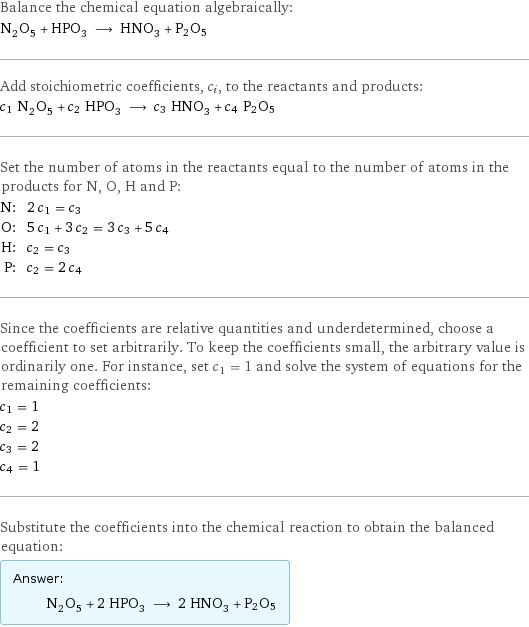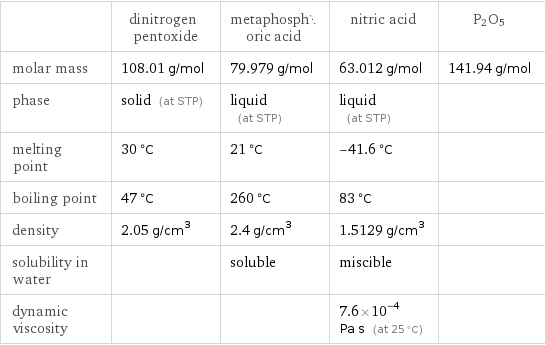Input interpretation

N_2O_5 dinitrogen pentoxide + HPO_3 metaphosphoric acid ⟶ HNO_3 nitric acid + P2O5
Balanced equation

Balance the chemical equation algebraically: N_2O_5 + HPO_3 ⟶ HNO_3 + P2O5 Add stoichiometric coefficients, c_i, to the reactants and products: c_1 N_2O_5 + c_2 HPO_3 ⟶ c_3 HNO_3 + c_4 P2O5 Set the number of atoms in the reactants equal to the number of atoms in the products for N, O, H and P: N: | 2 c_1 = c_3 O: | 5 c_1 + 3 c_2 = 3 c_3 + 5 c_4 H: | c_2 = c_3 P: | c_2 = 2 c_4 Since the coefficients are relative quantities and underdetermined, choose a coefficient to set arbitrarily. To keep the coefficients small, the arbitrary value is ordinarily one. For instance, set c_1 = 1 and solve the system of equations for the remaining coefficients: c_1 = 1 c_2 = 2 c_3 = 2 c_4 = 1 Substitute the coefficients into the chemical reaction to obtain the balanced equation: Answer: | | N_2O_5 + 2 HPO_3 ⟶ 2 HNO_3 + P2O5
Structures

+ ⟶ + P2O5
Names

dinitrogen pentoxide + metaphosphoric acid ⟶ nitric acid + P2O5
Equilibrium constant
![Construct the equilibrium constant, K, expression for: N_2O_5 + HPO_3 ⟶ HNO_3 + P2O5 Plan: • Balance the chemical equation. • Determine the stoichiometric numbers. • Assemble the activity expression for each chemical species. • Use the activity expressions to build the equilibrium constant expression. Write the balanced chemical equation: N_2O_5 + 2 HPO_3 ⟶ 2 HNO_3 + P2O5 Assign stoichiometric numbers, ν_i, using the stoichiometric coefficients, c_i, from the balanced chemical equation in the following manner: ν_i = -c_i for reactants and ν_i = c_i for products: chemical species | c_i | ν_i N_2O_5 | 1 | -1 HPO_3 | 2 | -2 HNO_3 | 2 | 2 P2O5 | 1 | 1 Assemble the activity expressions accounting for the state of matter and ν_i: chemical species | c_i | ν_i | activity expression N_2O_5 | 1 | -1 | ([N2O5])^(-1) HPO_3 | 2 | -2 | ([HPO3])^(-2) HNO_3 | 2 | 2 | ([HNO3])^2 P2O5 | 1 | 1 | [P2O5] The equilibrium constant symbol in the concentration basis is: K_c Mulitply the activity expressions to arrive at the K_c expression: Answer: | | K_c = ([N2O5])^(-1) ([HPO3])^(-2) ([HNO3])^2 [P2O5] = (([HNO3])^2 [P2O5])/([N2O5] ([HPO3])^2)](../image_source/5e0199523f768bd79d4b96888fb590cc.png)
Construct the equilibrium constant, K, expression for: N_2O_5 + HPO_3 ⟶ HNO_3 + P2O5 Plan: • Balance the chemical equation. • Determine the stoichiometric numbers. • Assemble the activity expression for each chemical species. • Use the activity expressions to build the equilibrium constant expression. Write the balanced chemical equation: N_2O_5 + 2 HPO_3 ⟶ 2 HNO_3 + P2O5 Assign stoichiometric numbers, ν_i, using the stoichiometric coefficients, c_i, from the balanced chemical equation in the following manner: ν_i = -c_i for reactants and ν_i = c_i for products: chemical species | c_i | ν_i N_2O_5 | 1 | -1 HPO_3 | 2 | -2 HNO_3 | 2 | 2 P2O5 | 1 | 1 Assemble the activity expressions accounting for the state of matter and ν_i: chemical species | c_i | ν_i | activity expression N_2O_5 | 1 | -1 | ([N2O5])^(-1) HPO_3 | 2 | -2 | ([HPO3])^(-2) HNO_3 | 2 | 2 | ([HNO3])^2 P2O5 | 1 | 1 | [P2O5] The equilibrium constant symbol in the concentration basis is: K_c Mulitply the activity expressions to arrive at the K_c expression: Answer: | | K_c = ([N2O5])^(-1) ([HPO3])^(-2) ([HNO3])^2 [P2O5] = (([HNO3])^2 [P2O5])/([N2O5] ([HPO3])^2)
Rate of reaction
![Construct the rate of reaction expression for: N_2O_5 + HPO_3 ⟶ HNO_3 + P2O5 Plan: • Balance the chemical equation. • Determine the stoichiometric numbers. • Assemble the rate term for each chemical species. • Write the rate of reaction expression. Write the balanced chemical equation: N_2O_5 + 2 HPO_3 ⟶ 2 HNO_3 + P2O5 Assign stoichiometric numbers, ν_i, using the stoichiometric coefficients, c_i, from the balanced chemical equation in the following manner: ν_i = -c_i for reactants and ν_i = c_i for products: chemical species | c_i | ν_i N_2O_5 | 1 | -1 HPO_3 | 2 | -2 HNO_3 | 2 | 2 P2O5 | 1 | 1 The rate term for each chemical species, B_i, is 1/ν_i(Δ[B_i])/(Δt) where [B_i] is the amount concentration and t is time: chemical species | c_i | ν_i | rate term N_2O_5 | 1 | -1 | -(Δ[N2O5])/(Δt) HPO_3 | 2 | -2 | -1/2 (Δ[HPO3])/(Δt) HNO_3 | 2 | 2 | 1/2 (Δ[HNO3])/(Δt) P2O5 | 1 | 1 | (Δ[P2O5])/(Δt) (for infinitesimal rate of change, replace Δ with d) Set the rate terms equal to each other to arrive at the rate expression: Answer: | | rate = -(Δ[N2O5])/(Δt) = -1/2 (Δ[HPO3])/(Δt) = 1/2 (Δ[HNO3])/(Δt) = (Δ[P2O5])/(Δt) (assuming constant volume and no accumulation of intermediates or side products)](../image_source/e41a6937f1aa6f33bce0c63a583b33d4.png)
Construct the rate of reaction expression for: N_2O_5 + HPO_3 ⟶ HNO_3 + P2O5 Plan: • Balance the chemical equation. • Determine the stoichiometric numbers. • Assemble the rate term for each chemical species. • Write the rate of reaction expression. Write the balanced chemical equation: N_2O_5 + 2 HPO_3 ⟶ 2 HNO_3 + P2O5 Assign stoichiometric numbers, ν_i, using the stoichiometric coefficients, c_i, from the balanced chemical equation in the following manner: ν_i = -c_i for reactants and ν_i = c_i for products: chemical species | c_i | ν_i N_2O_5 | 1 | -1 HPO_3 | 2 | -2 HNO_3 | 2 | 2 P2O5 | 1 | 1 The rate term for each chemical species, B_i, is 1/ν_i(Δ[B_i])/(Δt) where [B_i] is the amount concentration and t is time: chemical species | c_i | ν_i | rate term N_2O_5 | 1 | -1 | -(Δ[N2O5])/(Δt) HPO_3 | 2 | -2 | -1/2 (Δ[HPO3])/(Δt) HNO_3 | 2 | 2 | 1/2 (Δ[HNO3])/(Δt) P2O5 | 1 | 1 | (Δ[P2O5])/(Δt) (for infinitesimal rate of change, replace Δ with d) Set the rate terms equal to each other to arrive at the rate expression: Answer: | | rate = -(Δ[N2O5])/(Δt) = -1/2 (Δ[HPO3])/(Δt) = 1/2 (Δ[HNO3])/(Δt) = (Δ[P2O5])/(Δt) (assuming constant volume and no accumulation of intermediates or side products)
Chemical names and formulas

| dinitrogen pentoxide | metaphosphoric acid | nitric acid | P2O5 formula | N_2O_5 | HPO_3 | HNO_3 | P2O5 Hill formula | N_2O_5 | HO_3P | HNO_3 | O5P2 name | dinitrogen pentoxide | metaphosphoric acid | nitric acid | IUPAC name | nitro nitrate | phosphenic acid | nitric acid |
Substance properties

| dinitrogen pentoxide | metaphosphoric acid | nitric acid | P2O5 molar mass | 108.01 g/mol | 79.979 g/mol | 63.012 g/mol | 141.94 g/mol phase | solid (at STP) | liquid (at STP) | liquid (at STP) | melting point | 30 °C | 21 °C | -41.6 °C | boiling point | 47 °C | 260 °C | 83 °C | density | 2.05 g/cm^3 | 2.4 g/cm^3 | 1.5129 g/cm^3 | solubility in water | | soluble | miscible | dynamic viscosity | | | 7.6×10^-4 Pa s (at 25 °C) |
Units
